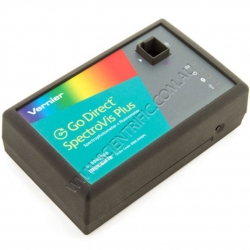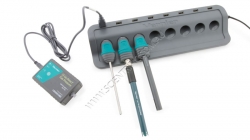
Enlarge

Purchase GDX-CRG to recharge multiple Go Direct sensors
Enlarge

Enlarge

Purchase GDX-CRG to recharge multiple Go Direct sensors
Enlarge
Vernier Go Direct SpectroVis Plus Spectrophotometer - Spectrometer
Order code: GDX-SVISPL-INTLVERNIER GO DIRECT SPECTROVIS PLUS SPECTROPHOTOMETER.
Vernier's Go Direct SpectroVis Plus Spectrophotometer quickly measures a full wavelength spectrum. It directly connects wirelessly via Bluetooth® or wired via USB to your platform.
Introduce your students to spectroscopy with the affordable Vernier Go Direct SpectroVis Plus Spectrophotometer. This device can easily collect a full wavelength spectrum (absorbance, percent transmission or intensity) in less than one second. Once the peak wavelength is determined you can establish the concentration of a solution (Beers law) or monitor rates of reactions. A low light path allows the Go Direct SpectroVis Plus Spectrophotometer to be used for microscale labs and biochemistry applications with micro and semi-micro cuvettes.
The Vernier Go Direct SpectroVis Plus Spectrophotometer can be used in a variety spectroscopy experiments:
Determine peak wavelength to collect data on solution concentration for studies of Beers law or to monitor rates of reaction
Collect a full wavelength spectrum to measure absorbance, percent transmittance, fluorescence (at 405 nm or 500 nm excitation) or emissions
Conduct enzyme kinetics experiments
Engage in equilibrium studies of absorbance vs. time or absorbance vs. concentration
Perform colorimetric or fluorescent bioassays
Use the Spectrophotometer Optical Fiber to measure emissions from flame tests or other light sources. For more detailed emissions analysis consider the Vernier Emissions Spectrometer.
How Go Direct SpectroVis Plus Works
The Go Direct SpectroVis Plus Spectrophotometer employs an LED and tungsten bulb to transmit light through a high-quality diffraction grating. The diffracted light is sorted and collected by the linear CCD array detector.
Spectroscopy with Go Direct SpectroVis Plus
To use the Vernier Go Direct SpectroVis Plus Spectrophotometer download the free Spectral Analysis app. The app is compatible with computers, Chromebooks, and mobile devices.
Students may also connect to LabQuest 2, LabQuest 3 or a computer with Logger Pro 3 to perform analysis.
Vernier's Go Direct SpectroVis Plus connects directly to your platform - wirelessly via Bluetooth or wired via USB - and requires data collection software.
NOTES:
This product replaces the original Vernier SpectroVis Plus Spectrometer (SVIS-PL).
The old SVIS-FIBER is NOT compatible with GDX-SVISPL, instead purchase VSP-FIBER Vernier Spectrophotometer Optical Fiber
Specifications:
Wavelength Range: 380nm950nm
Support for fluorescence: Two excitation sources centered at 405nm and 500nm
Reported Wavelength Interval: ~1nm between reported values (collects 570 values)
Optical resolution (FWHM): 5.0nm
Wavelength accuracy: ± 4.0nm
Photometric accuracy: ± 0.10 A.U.
Light Sources: Incandescent white bulb, approximately 8,000 hour lifetime, one-step calibration. LED-based, approximately 100,000 hour lifetime. No external power is required.
Typical scan time: ~2 s
Connections:
Wireless: Bluetooth
Wired: USB
Included:
Vernier Go Direct SpectroVis Plus Spectrophotometer
15 plastic cuvettes and lids
Vernier mini USB cable
Power supply
Educational use only:
Vernier and Kidwind products are designed for educational use. They are not appropriate for industrial, medical or commercial applications. Details
Warranty
- Warranty: 5 years (3 years on light source; cuvettes none)
Dimensions- Product size: (HxWxD): 40x150x90mm
- Package size (HxWxD): 89x133x203mm
- Packed weight: 610g
Last edited 13th Jan 2025
| Accessories / Spare Parts: | From |
| CB-USB-MICRO - Vernier Micro USB Cable | $12.00 |
| CB-USB-C-MICRO - Vernier Micro USB-C Cable | $22.00 |
| LQ3-PS-INTL - Vernier LabQuest 3 International Power Supply | $40.00 |
| GDX-BAT-300 - Vernier Go Direct 300mAH Replacement Battery | $25.00 |
| CUV - Vernier Colorimeter Cuvettes | $60.00 |
| CUV-UV - Vernier UV-VIS Cuvettes | $468.00 |
| VSP-FIBER - Vernier Spectrophotometer Optical Fiber suits GDX-SVISPL, VSP-FUV, VSP-UV | $196.00 |
| Similar Products: | From |
| GDX-TMP - Vernier Go Direct Temperature Probe | $196.00 |
| VSP-EM - Vernier Emissions Spectrometer | $1,940.00 |
| GDX-WRT - Vernier Go Direct Wide Range Temperature Probe | $345.00 |
| GDX-ST - Vernier Go Direct Surface Temperature Sensor | $246.00 |
| GDX-PH - Vernier Go Direct pH Sensor | $271.00 |
| GDX-ACC - Vernier Go Direct Acceleration Sensor | $286.00 |
| GDX-FOR - Vernier Go Direct Force and Acceleration Sensor | $296.00 |
| GDX-FPH - Vernier Go Direct Tris Compatible Flat pH Sensor | $345.00 |
| GDX-GPH - Vernier Go Direct Glass-Body pH Sensor | $395.00 |
| GDX-CUR - Vernier Go Direct Current Probe | $246.00 |
| GDX-RB - Vernier Go Direct Respiration Belt | $311.00 |
| GDX-RMS - Vernier Go Direct Rotary Motion Sensor | $485.00 |
| GDX-3MG - Vernier Go Direct 3-Axis Magnetic Field Sensor | $246.00 |
| GDX-CON - Vernier Go Direct Conductivity Probe | $321.00 |
| GDX-COL - Vernier Go Direct Colorimeter | $336.00 |
| GDX-DC - Vernier Go Direct Drop Counter | $286.00 |
| GDX-GP - Vernier Go Direct Gas Pressure Sensor | $261.00 |
| GDX-LC - Vernier Go Direct Light and Colour Sensor | $246.00 |
| GDX-MD - Vernier Go Direct Motion Detector | $321.00 |
| GDX-ORP - Vernier Go Direct ORP Sensor | $296.00 |
| GDX-RAD - Vernier Go Direct Radiation Monitor - Geiger Counter | $544.00 |
| GDX-VOLT - Vernier Go Direct Voltage Probe | $236.00 |
| GDX-EA - Vernier Go Direct Electrode Amplifier | $196.00 |
Documents: Catalogue | Vernier Catalogue K-12 | Catalogue | Vernier Catalogue Uni | Catalogue | Scientrific April 2025 Mini Catalogue | Catalogue | Vernier 2025 K-12 Catalogue | Catalogue | Vernier 2025 University Catalogue | | |||||||||||
Note: Prices do NOT include GST or freight



 ,
,